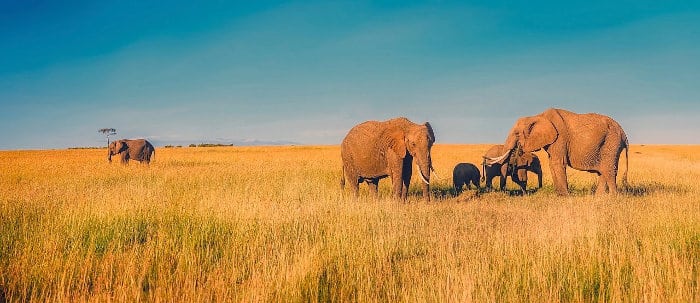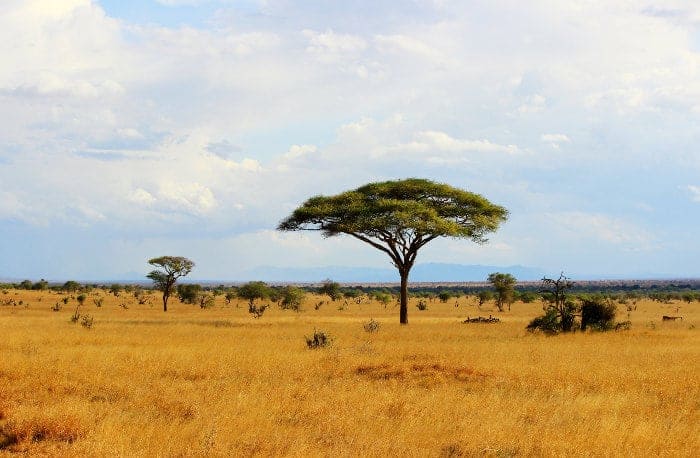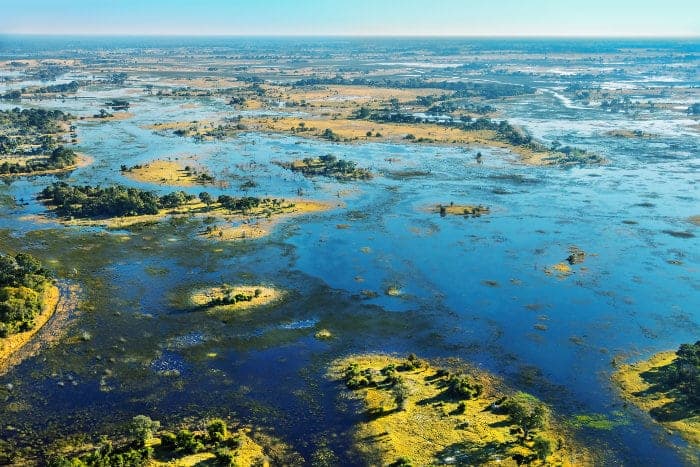
Some people arrive in Africa expecting to see lions on the runway. Or rhinos charging past their hotel room.
Yes, Africa is wild, but you can’t expect to see all the famous animals in one place, and certainly not next to a Boeing 787. Each of the continent’s habitats creates a canvas of impressions.
These are the places you will explore and each habitat is favoured by a particular cast of animals.
For example, grazers like wildebeest and zebra need grass, so you’ll find lots of them on the grasslands. Elephants and giraffe eat from trees, so they are more numerous around woodland.
Some destinations like the Ngorongoro Crater have six different habitats in one. In other destinations, like the Serengeti, you can spend three days seeing nothing but grass. But every habitat you visit is dictated by water.
Life revolves around water: desert waterholes, riverine forest, floodplains that extend and shrink with the seasons.
Water is the constant that ties everything in Africa together, and it’s usually where you’ll find the highest concentrations of animals.
Every habitat has a unique feel and a safari in the woodland is nothing like a safari on the savannah.
Each habitat brings a new experience, which is why you should safari to at least two different destinations. It will feel like two different holidays in one!
For example, in Botswana you can combine elephant-filled Chobe woodland with the Okavango Delta and the desert landscape of the Central Kalahari.
Tanzania’s northern circuit takes in four parks in one week, each distinct from the last.
Grasslands

Dancing with legendary scenes, open grasslands are where grazers thrive and predators follow.
They exist in East Africa and are created by a short, annual rainy season, which nourishes the grass for migratory wanderers.
A safari on the grassland is all about scale. All you can see is grass, extending for miles and miles in every direction. And because the landscape is so open you can’t miss the wildlife.
With such an endless view you’ll encounter many thousands of wild animals. The Serengeti and Maasai Mara are the most famous, but there are others across Tanzania, Kenya and Uganda.
Savannah

A savannah is the famous image of Africa.
These are grasslands punctuated by trees and shrubs, so they offer food for many species, meaning the savannah is where you’ll encounter the greatest diversity of wildlife.
Rhinos, elephants, lions, leopards, buffalo, zebra, hippos, and that might all be on one game drive!
South Africa’s Kruger is one example, but also consider parks like Tsavo in Kenya, Tarangire and Selous in Tanzania, and private concessions in northern Botswana.
Woodland

Remember the song: “in the jungle, the mighty jungle, the lion sleeps tonight.” It’s so wrong! Lions don’t live in the jungle and you won’t go on a jungle safari to see big cats.
Lions do occupy the woodland, although these landscapes are mostly dominated by tree-loving specialists. Like elephants, giraffe, baboons, monkeys, incredible birdlife and strange antelope.
Woodland is thick so you can’t see as far, meaning you won’t spot as many animals, even if lots of animals live there.
However, the animals might not see you coming, so in a woodland you get incredibly close to the action, sometimes with elephants towering high above your safari vehicle.
Try Chobe National Park in Botswana or Zambia’s South Luangwa National Park for a really intense woodland safari.
Semi-Desert

It’s the specialists that survive in the desert, covering great distances in search of water.
Deserts are huge but wildlife is easy to find if you can think like the animals. Just follow the water, where dramatic scenes play out beneath the sun.
Hungry predators, thirsty herds, tired nomads and an incredible level of excitement.
Try the Central Kalahari in Botswana, Namibia’s Etosha National Park, or Kenya’s Samburu. Just make sure you have enough time, because deserts are enormous wildernesses.
Wetlands and Floodplains

The rain comes and the rain provides. The landscape flourishes, turning green and attracting life from all corners of the continent. Wetlands and floodplains are usually seasonal, so check the best time to go carefully.
Time it right and you could be treated to the greatest natural show on earth, such as in Botswana’s Okavango Delta.